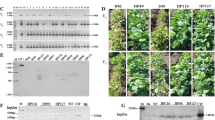Abstract
Using harpin protein gene from apple fire blight pathogenErwinia amylovora and potato prp1-1 promoter as main DNA elements, the feasibility of using pathogen infection-induced hypersensitive response was explored as a new strategy of engineering fungal disease resistance. Three plant transformation vectors were constructed and 68 transgenic potato plants were produced throughAgrobacterium mediated transformation method. Southern, Northern and Western blot analysis demonstrated the insertion, transcription and protein expression of harpin protein gene in transgenic plants. Disease resistance test using a complex race ofPhytophthora infestans as challenging pathogen showed that both constitutive and pathogen infection-induced expression of harpin protein gene in transgenic potato reduced the lesion growth rate of fungus. Among plants where harpin protein gene expression was induced only by fungus infection, two plants were found to be highly resistant to P.infestans infection. Fungal hyphae were not produced on total of 30 inoculated leaves from the two resistant plants and necrotic lesion was limited to inoculation area. The results highlighted that engineered hypersensitive response in plants was a very promising approach to produce fungal disease resistant genotype.
Similar content being viewed by others
References
Li Rugang, Molecular basis plant-pathogen interactions and disease control strategy,Chinese Journal of Agrobiotechnology (in Chinese), 1994, 2(1): 1.
de Wit, P. J. G. M., Molecular characterization of gene-for-gene systems in plant-fungal interactions and the application of avirulence genes in control of plant pathogens,Annu. Rev. Phytopathology, 1992, 30: 391.
Pfitzner, U. M., Pfitzner, A. J. P., Expression of an avirulence gene in transgenic plants is sufficient to induce the hypersensitive reaction,Mol. Plant-Microbe. Interactions, 1992, 5: 318.
Hammond-Kosack, K. E., Harrison, K., Jones, J. D. G., Developmentally regulated cell death on expression of the fungal avirulence geneavr9 in tomato seedlings carrying the disease resistance gene Cf-9,Proc. Natl. Acad. Sci. USA, 1994, 91: 10444.
Strittmatter, G., Janssens, J., Opsomer, C. et al., Inhibition of fungal disease development in plant by engineering controlled cell death,Bio/Technology, 1995, 13: 1085.
Wei, Z. M., Laby, R. J., Zumoff, C. H. et al., Harpin, elicitor of hypersensitive response produced by the plant pathogenErwinia amylovora, Science, 1992, 257: 85.
Li Rugang, Shi Guang Chun, Fan Yunliu et al., Cloning and sequencing of Harpin protein gene,Chinese Journal of Plant Pathology (in Chinese), 1998, 28 (1).
vanEngelen, F. A., Molthoff, J. W., Conner, A. J. et al., pBINPLUS: an improved plant transformation vector based on pBIN19,Transgenic Res., 1995, 4(4): 288.
Sambrook, J., Fritsch, E. F., Maniatis, T.,Molecular Cloning: A Laboratory Manual, NY: Cold Spring Harbor Laboratory Press, 1989.
Visser, R. G. F., Jaconsen, E., Hesseling-Meinders, A. et al., Transformation of homozygous diploid potato with anAgrobacterium tumefaciens binary vector system by adventitious shoot regeneration on leaf and stem segments,Plant Molecular Biology, 1989, 12: 329.
de Wit, P. J. G. M., Spikman, G., Evidence for the occurrence of race and cultivar-specific elicitors of necrosis in intercellular fluids of compatible interactions ofCladosporium fulvum and tomato,Physiological Plant Pathology, 1982, 21: 1.
Caten, C. E., Jinks, J. L., Spontaneous variability of single isolate ofPhytophthora infestans (I)—Cultural variation,Canadian Journal of Botany, 1986, 46: 329.
Martini, N., Egen, N., Runtz, I. et al., Promoter sequences of a potato pathogenesis-related gene mediate transcriptional activation selectively upon fungal infection,Mol. Gen. Genet., 1993, 236: 179.
Payne, G., Parks, T. D., Burkhart, W. et al., Isolation of the genomic clones for pathogenesis-related protein la fromNicotiana tabacum cv. Xanthi-nc,Plant Mol. Biol., 1988, 11: 89.
Greenberg, J. T., Programmed cell death in plant-pathogen interactions,Annu. Rev. Plant Physiol. Plant Mol. Biol., 1997, 48: 525.
Author information
Authors and Affiliations
Additional information
Project partly supported by the Molecular Biology Laboratory of CPRO-DLO in Netherlands.
Rights and permissions
About this article
Cite this article
Li, R., Fan, Y. Reduction of lesion growth rate of late blight plant disease in transgenic potato expressing harpin protein. Sci. China Ser. C.-Life Sci. 42, 96–101 (1999). https://doi.org/10.1007/BF02881754
Received:
Issue Date:
DOI: https://doi.org/10.1007/BF02881754




